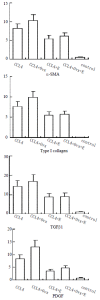Estrogen reduces CCL4- induced liver fibrosis in rats
- PMID: 12378635
- PMCID: PMC4656580
- DOI: 10.3748/wjg.v8.i5.883
Estrogen reduces CCL4- induced liver fibrosis in rats
Abstract
Aim: Chronic liver diseases, such as fibrosis or cirrhosis, are more common in men than in women. This gender difference may be related to the effects of sex hormones on the liver. The aim of the present work was to investigate the effects of estrogen on CCL(4)-induced fibrosis of the liver in rats.
Methods: Liver fibrosis was induced in male, female and ovariectomized rats by CCL(4) administration. All the groups were treated with estradiol(1 mg/kg) twice weekly. And tamoxifen was given to male fibrosis model. At the end of 8 weeks, all the rats were killed to study serum indicators and the livers.
Results: Estradiol treatment reduced aspartate aminotransferase(AST), alanine aminotransferase (ALT), hyaluronic acid(HA) and type IV collagen(CIV) in sera, suppressed hepatic collagen content, decreased the areas of hepatic stellate cells (HSC) positive for alpha-smooth muscle actin (alpha-SMA), and lowered the synthesis of hepatic type I collagen significantly in both sexes and ovariectomy fibrotic rats induced by CCL(4) administration. Whereas, tamoxifen had the opposite effect. The fibrotic response of the female liver to CCL(4) treatment was significantly weaker than that of male liver.
Conclusion: Estradiol reduces CCL(4)-induced hepatic fibrosis in rats. The antifibrogenic role of estrogen in the liver may be one reason for the sex associated differences in the progression from hepatic fibrosis to cirrhosis.
Figures


Similar articles
-
Effects of estradiol on liver estrogen receptor-alpha and its mRNA expression in hepatic fibrosis in rats.World J Gastroenterol. 2004 Jan 15;10(2):250-4. doi: 10.3748/wjg.v10.i2.250. World J Gastroenterol. 2004. PMID: 14716833 Free PMC article.
-
Effects of extract from Ginkgo biloba on carbon tetrachloride-induced liver injury in rats.World J Gastroenterol. 2006 Jun 28;12(24):3924-8. doi: 10.3748/wjg.v12.i24.3924. World J Gastroenterol. 2006. PMID: 16804984 Free PMC article.
-
Effect and mechanism of methyl helicterate isolated from Helicteres angustifolia (Sterculiaceae) on hepatic fibrosis induced by carbon tetrachloride in rats.J Ethnopharmacol. 2012 Oct 11;143(3):889-95. doi: 10.1016/j.jep.2012.08.018. Epub 2012 Aug 28. J Ethnopharmacol. 2012. PMID: 22967666
-
Effect of WeiJia on carbon tetrachloride induced chronic liver injury.World J Gastroenterol. 2006 Mar 28;12(12):1912-7. doi: 10.3748/wjg.v12.i12.1912. World J Gastroenterol. 2006. PMID: 16609998 Free PMC article.
-
Hepatoprotective effects of phloridzin on hepatic fibrosis induced by carbon tetrachloride against oxidative stress-triggered damage and fibrosis in rats.Biol Pharm Bull. 2012;35(7):1118-25. doi: 10.1248/bpb.b12-00057. Biol Pharm Bull. 2012. PMID: 22791160
Cited by
-
Effects of metformin on knee joint capsule fibrosis in a diabetic mouse model.Bone Joint Res. 2024 Jul 3;13(7):321-331. doi: 10.1302/2046-3758.137.BJR-2023-0384.R1. Bone Joint Res. 2024. PMID: 38955349 Free PMC article.
-
Modulation of vascular contraction via soluble guanylate cyclase signaling in a novel ex vivo method using rat precision-cut liver slices.Pharmacol Res Perspect. 2021 May;9(3):e00768. doi: 10.1002/prp2.768. Pharmacol Res Perspect. 2021. PMID: 34014044 Free PMC article.
-
Prevention of critical telomere shortening by oestradiol in human normal hepatic cultured cells and carbon tetrachloride induced rat liver fibrosis.Gut. 2004 Jul;53(7):1001-9. doi: 10.1136/gut.2003.027516. Gut. 2004. PMID: 15194652 Free PMC article.
-
Effects of estradiol on liver estrogen receptor-alpha and its mRNA expression in hepatic fibrosis in rats.World J Gastroenterol. 2004 Jan 15;10(2):250-4. doi: 10.3748/wjg.v10.i2.250. World J Gastroenterol. 2004. PMID: 14716833 Free PMC article.
-
Effect of metformin treatment and its time of administration on joint capsular fibrosis induced by mouse knee immobilization.Sci Rep. 2021 Sep 9;11(1):17978. doi: 10.1038/s41598-021-97445-7. Sci Rep. 2021. PMID: 34504209 Free PMC article.
References
-
- Tan E, Gurjar MV, Sharma RV, Bhalla RC. Estrogen receptor-alpha gene transfer into bovine aortic endothelial cells induces eNOS gene expression and inhibits cell migration. Cardiovasc Res. 1999;43:788–797. - PubMed
-
- Pinzani M, Romanelli RG, Magli S. Progression of fibrosis in chronic liver diseases: time to tally the score. J Hepatol. 2001;34:764–767. - PubMed
-
- Yan JC, MA JY, Pan BR, MA LS. Study of hepatitis B in China. Shijie Huaren Xiaohua Zazhi. 2001;9:611–616.
Publication types
MeSH terms
Substances
LinkOut - more resources
Full Text Sources
Medical

